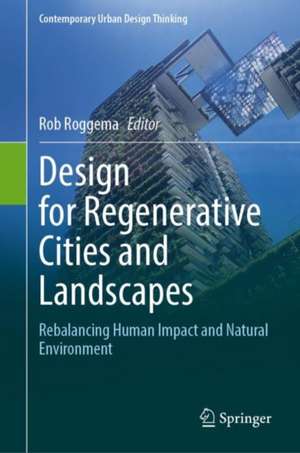Design for Regenerative Cities and Landscapes: Rebalancing Human Impact and Natural Environment: Contemporary Urban Design Thinking
Editat de Rob Roggemaen Limba Engleză Hardback – 7 mai 2022
| Toate formatele și edițiile | Preț | Express |
|---|---|---|
| Paperback (1) | 729.50 lei 43-57 zile | |
| Springer International Publishing – 8 mai 2023 | 729.50 lei 43-57 zile | |
| Hardback (1) | 600.25 lei 38-44 zile | |
| Springer International Publishing – 7 mai 2022 | 600.25 lei 38-44 zile |
Preț: 600.25 lei
Preț vechi: 789.81 lei
-24% Nou
Puncte Express: 900
Preț estimativ în valută:
114.85€ • 120.24$ • 95.04£
114.85€ • 120.24$ • 95.04£
Carte tipărită la comandă
Livrare economică 02-08 aprilie
Preluare comenzi: 021 569.72.76
Specificații
ISBN-13: 9783030970222
ISBN-10: 3030970221
Pagini: 305
Ilustrații: XVIII, 305 p. 163 illus., 150 illus. in color.
Dimensiuni: 155 x 235 mm
Greutate: 0.71 kg
Ediția:1st ed. 2022
Editura: Springer International Publishing
Colecția Springer
Seria Contemporary Urban Design Thinking
Locul publicării:Cham, Switzerland
ISBN-10: 3030970221
Pagini: 305
Ilustrații: XVIII, 305 p. 163 illus., 150 illus. in color.
Dimensiuni: 155 x 235 mm
Greutate: 0.71 kg
Ediția:1st ed. 2022
Editura: Springer International Publishing
Colecția Springer
Seria Contemporary Urban Design Thinking
Locul publicării:Cham, Switzerland
Cuprins
1. Design for Regeneration.- 2. The city sustainable, resilient, regenerative – a rose by any other name?.- 3. Using Indigenous knowledge in Climate Resistance strategies for Future Urban Environments.- 4. Mutability and accelerated culture: designing regenerative systems in low-density landscapes.- 5. Regenerating a country by design: Nature-rich Netherlands.- 6. Design for Regeneration -a nature-based perspective on cities.- 7. In-between nature: reconsidering design practices for territories in-between from a social-ecological perspective.- 8. Regeneration of degraded land with nature-based solutions.- 9. The New Local Lens – a framework for local place regeneration and economic diversification.- 10. Brisbane 2032: The promise of the first carbon-positive Olympics for regenerative cities.- 11. The Necessity of Gardening. About Landscape, Strategy and Design in Times of Uncertainty.- 12. Urban green benefits.- 13. Overtaking hindsight.
Notă biografică
Prof. dr. ir. Rob Roggema is Landscape Architect, Professor Landscape Driven Design at InHolland University of Applied Sciences, and founder of Cittaideale, office for adaptive design and planning, and visiting professor at Queens University Belfast. He is lead-author of the Architecture, Urban Design and Planning chapter of the third assessment report of the UCCRN. He held several professorship positions at VHL University (Professor of Design for Urban Agriculture 2014-2016), University of Technology Sydney (Professor of Sustainable Urban Environments 2016-2018) and Hanze University Groningen (Professor of Spatial Transformations 2019-2021). Before 2010 he worked for the province of Groningen and municipalities such as Almere, Breda and Rotterdam on the design of ecological and sustainable cities and landscapes. Recently, he led the design of a Nature-Rich Netherlands, the climate adaptive design 2021 for the Groningen region, he initiated the FEW-nexus project ‘the Moveable Nexus’, and he designed the Edible Park in Ede, the Netherlands. Rob has facilitated over 40 design charrettes worldwide and has presented his work at conferences and symposia all around the world.
Textul de pe ultima copertă
This book discusses the way to design and plan for regenerative cities and landscapes. Where sustainability aims to safeguard the resources for future generations, and the resilience concept focuses on dealing with shocks to keep the system functioning, regeneration aims to give back more than it takes from the system. This principle is often used in analytical and assessment literature, but not yet elaborated in a spatial planning and design context, which this book does. It offers insights from a range of perspectives, spatial scales, such as the country level, neighbourhood public space, streets and the building levels, scientific fields and continents, amongst which Africa, Oceania, and Europe.
Caracteristici
Socio-ecological systems thinking applied in urban design Design approaches for human-ecology interaction, where mankind is seen as a part of nature Regional and national landscape architecture for regenerative areas







